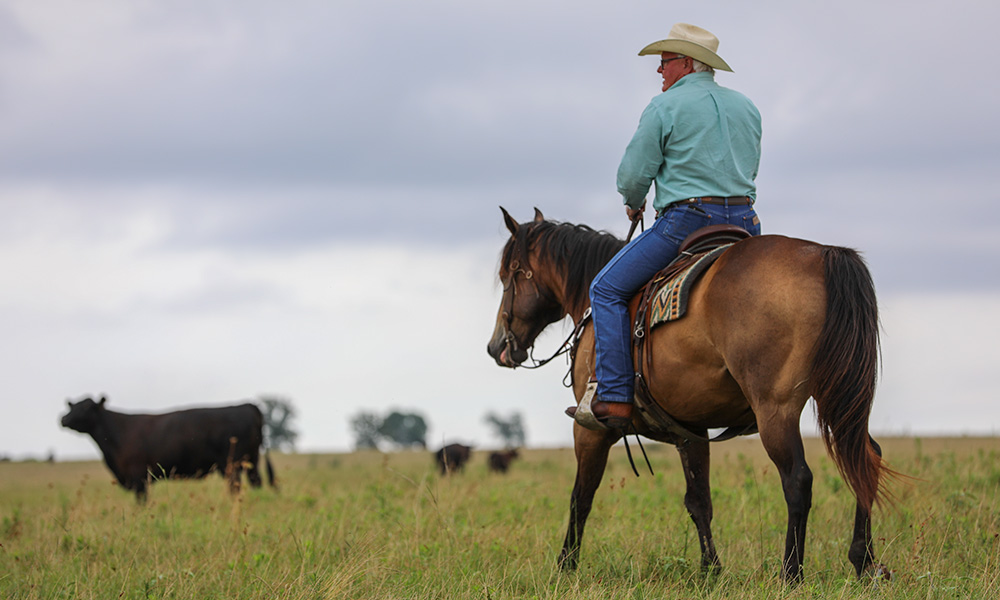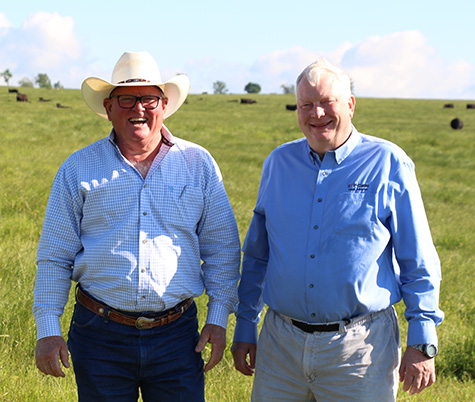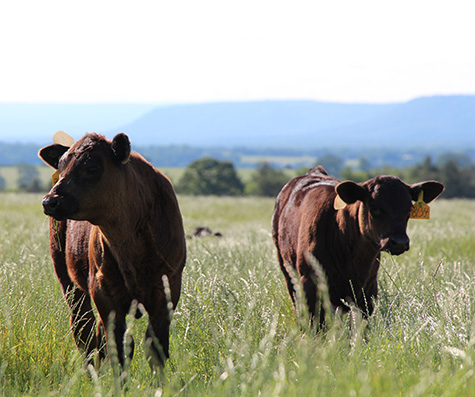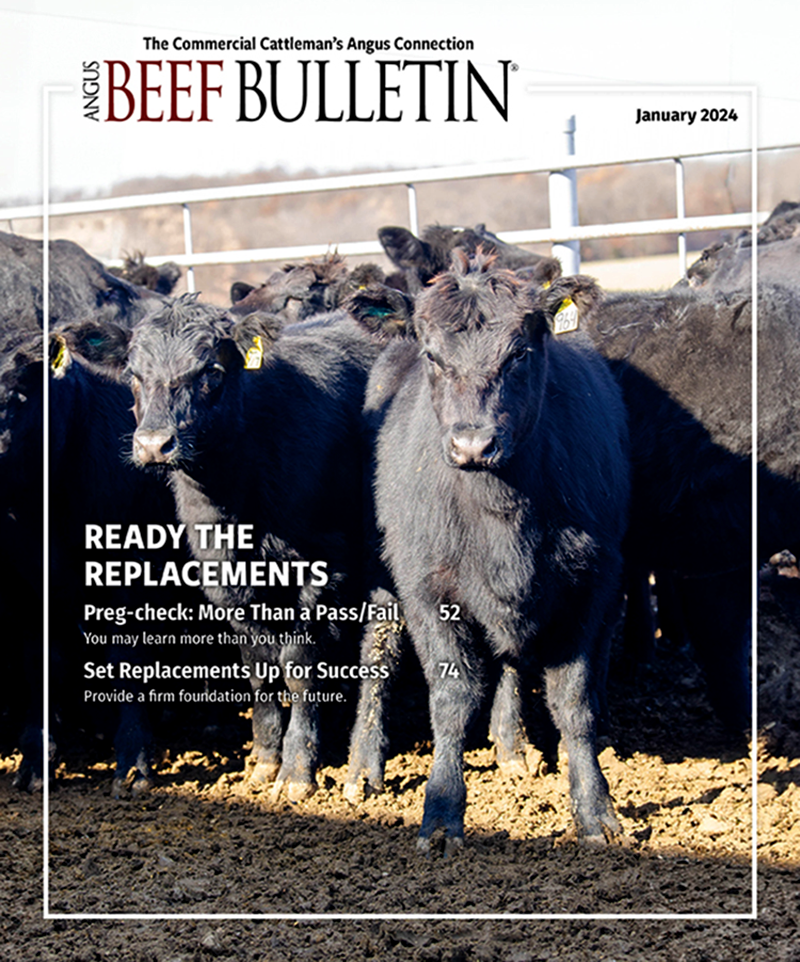
Pride & Precision
Arkansas cousins use technology to drive Angus success.
A hardware salesman and a hand surgeon walk into a pasture …
 |
“Having pride in what you are producing is very important,” David Taylor says. That’s why he and Phillip Smith (left) raise cattle with a specific purpose. |
For Phillip Smith and David Taylor, there’s no need for a punch line. What might sound like the start of a tall tale is a typical Tuesday afternoon.
Cattle have always been in the cards for these cousins from Ozark, Ark. Their grandfather, John Jacob Taylor, settled in the Cecil community after the Civil War and brought cows soon after.
“Any kind of cropping just doesn’t work well here,” Smith says.
“The soil is silicone-based,” Taylor adds. “It’s thin and retains little water, but we grow grass really well, so cattle are the best way to approach it.”
The corner of his mouth starts to shift.
“It’s just a giant solar panel that takes oxygen, carbon dioxide, water and sunlight to produce grass,” he says. “Grass doesn’t have a lot of value, but we have these great machines out here, these black machines,” he laughs, “that take that grass and make something of high value.”
It’s true, evidenced by a recent closeout of the cousins’ cattle that says 73% achieved Certified Angus Beef® (CAB®) and Prime.
“Having pride in what you are producing is very important,” Taylor says. That’s why he and Smith raise cattle with a specific purpose and why CAB honored them with the 2018 Commercial Commitment to Excellence Award.
Their partnership, STP Cattle, is built on what the brand stands for, and those “machines” are top-of-the-line.
“We want to grow something Phillip and I wouldn’t hesitate to eat ourselves,” Taylor says.
So, in 2009 they purchased a tract of land and combined resources. From there they researched their options, analyzed every possible avenue and reached a conclusion: There are economic opportunities and additional profits to be made for those willing to produce high-quality cattle.
“We have the grid system in place now that reflects that,” Taylor says.
They background calves, sort off replacement heifers and then finish the rest to see those dollars.
Better together
Why did the unlikely duo commit to The Business Breed?
Born a year apart, Taylor and Smith grew up together near the 65-acre homestead their grandfather purchased in 1865. Family, but even better friends, they went through adolescence and high school together before Taylor went to college and Smith carried on his father’s legacy in hardware and electrical work in town.
 |
For Arkansas, it may be easier to raise something that’s less straight Angus, Tom Williams says, “but phenotypically these cattle are stout, their frame size fits their muscle package, and they marble. He’s striving for 100% CAB.” |
All the while he kept a herd of “sale-barn cattle,” but Taylor sold his herd of similar quality after his parents’ early passing. It was medical school and surgical residency after that.
The Dallas-based doctor spent years studying and decades fixing people before picking cattle up again as a second job. His specialties — nerve reconstruction and improving on birth defects — earned him distinction from peers and gratitude from patients. Both bring humility to Taylor, who enjoys the chance to bring precision to what many consider the simpler world of ranching.
No matter the information he holds from hours of research, he knows there’s always more to learn, something he and Smith can do better.
Fast and furious
The commercial pairs grazing both sides of the road reflect that desire. The simple terms they use to describe partnership goals seem inadequate to account for how their cattle appear: planned out, with intention behind every mating.
“We want a bull that has balance, strength, no extremes in one area or another,” Taylor says. Expected progeny differences (EPDs) in the high percentiles for marbling with moderate birth weight and frame size rank high on their list of sire qualifiers. Docility can serve as a tiebreaker.
Discouraged by the cost of replacement heifers that met their strict standards, the cousins started selecting for and breeding their own.
“The bulls that we are purchasing for AI (artificial insemination) and cleanup aren’t typically terminal sires, so they pretty much have to do everything,” Taylor says.
They find those bulls at Gardiner Angus Ranch, near Ashland, Kan., even though they AI every female.
“We have more control over our own destiny,” Smith says. “We’re selecting bulls that we could never possibly own.”
“AI simplifies the management,” Taylor says. By shortening the breeding window — 80% of STP calves are born in the first 30 days of the season — they’ve seen improvement in management, marketing and grass, he says.
It all ties together in a near-complete package that Tom Williams, Chappell (Neb.) Feedlot, takes off their hands come December. Since STP has both spring- and fall-calving herds, Williams will feed four or five groups of “peewees” off of cornstalks, weighing 550 pounds (lb.), throughout the spring before the fall calves arrive.
He credits the cousins’ use of technology and genetics as reason for improvement — acknowledging the cattle were off to a good start the first day he ever saw them.
In the six years since then, STP cattle have improved in marbling, cutability and performance, “now being the top or one of the top,” Williams says. “And we feed the good ones."
“We feed a lot of northern cattle here, obviously more than southern,” Williams says. “When I drive by them in the lot, I’ll tell people, ‘These cattle are from Arkansas,’ and they just give me this ‘What?’ face like they can’t believe it.”
For that part of the world, it may be easier to raise something that’s less straight Angus, Williams says, “but phenotypically these cattle are stout, their frame size fits their muscle package, and they marble. He’s striving for 100% CAB.”
Striving. Perhaps that’s the best way to describe the cousins. That effort has placed them on a good trajectory that keeps getting better.
Editor’s Note: Laura Conaway is a producer communications specialist for Certified Angus Beef LLC. This is a condensed version of the story; to read the full article, see the November Angus Beef Bulletin. This newly redesigned Angus Beef Bulletin EXTRA is a companion to the Angus Beef Bulletin. Subscribe to both magazines at the top of the page to see even more new bells and whistles.



